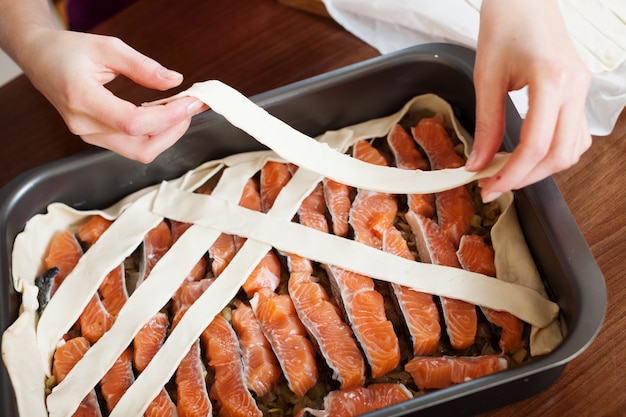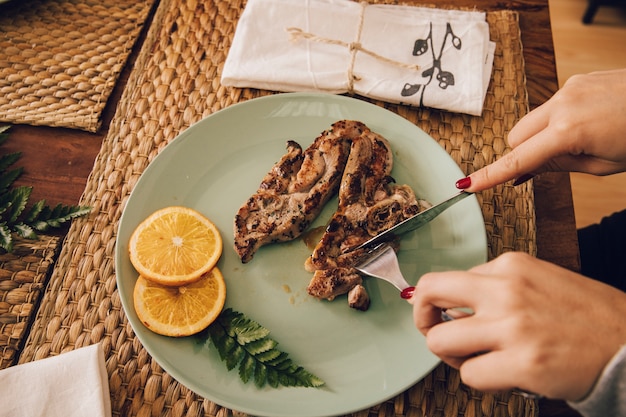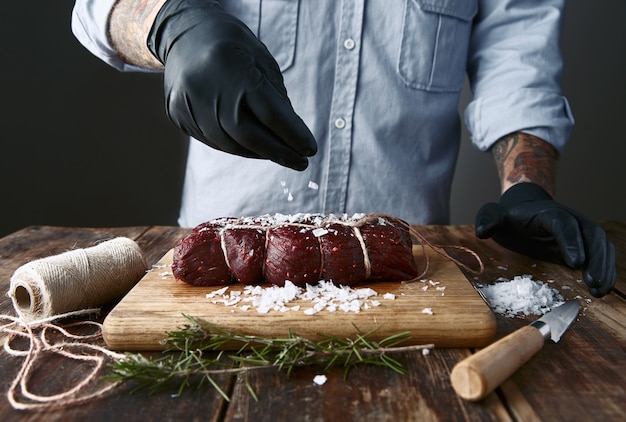There's nothing quite like the aroma of slow-smoked ribs, their tender meat practically falling off the bone, the smoky flavour dancing on your tongue. But achieving that perfect rib experience? That's where the magic of temperature comes in. It's not just about throwing a rack on the smoker and hoping for the best. Getting those ribs just right is a science, but don't worry, I'm here to break down the complexities and give you the tools you need to become a rib-cooking master.
(Part 1) The Science Behind rib cooking: Unlocking Tenderness

Before we dive into the nitty-gritty of temperatures, let's understand the science behind what makes ribs so darn delicious. Ribs are made up of muscle tissue, and when you cook them, the muscle fibres break down, creating that melt-in-your-mouth tenderness we all crave. But there's more to it than just heat – moisture plays a starring role.
The Moisture Game: Why Low and Slow Reigns Supreme
Think of cooking ribs like a delicate dance between heat and moisture. Too much heat and the moisture evaporates too quickly, leaving you with dry, tough ribs. That's why low and slow cooking is the key to succulent, flavour-packed ribs. This gentle approach allows the moisture to penetrate the meat, transforming those tough fibres into a symphony of tender, juicy goodness.
Collagen: The Secret Ingredient to Rib Perfection
Hidden within the connective tissues of ribs is collagen, a protein that's crucial to their transformation. During slow cooking, collagen breaks down into gelatin, which adds that irresistible richness and juicy texture we associate with perfectly cooked ribs. This is why low temperatures are essential – they give the collagen time to do its magic. Think of it as the secret ingredient that unlocks the magic of ribs.
Temperature Control: Your Pathway to Consistency
Temperature control isn't just about hitting the right number; it's about maintaining that number throughout the cooking process. Fluctuations in temperature can lead to uneven cooking, with some parts of the rib dry and tough while others remain undercooked. This is where a good thermometer and a controlled cooking environment come into play, ensuring that every part of the rib is cooked evenly, yielding consistent results.
(Part 2) Rib Types: Knowing Your Meat, Understanding Your Options

Not all ribs are created equal. There are three main types commonly used for grilling and smoking, each with its unique characteristics:
- Baby back ribs: These are the darlings of the rib world – shorter, meatier, and often favoured for their quicker cooking time. They have a higher fat content, which contributes to their rich flavour and melt-in-your-mouth tenderness.
- spare ribs: Longer and larger than their baby back counterparts, these ribs have more connective tissue, requiring a longer cooking time. They offer a more robust flavour and are often praised for their "bark" – the crispy outer layer that adds a satisfying crunch.
- St. Louis Ribs: These are spare ribs that have been trimmed of the bony flap and cartilage, creating a more uniform shape for easier cooking. They retain the same flavour and tenderness as traditional spare ribs.
The type of rib you choose will influence the cooking temperature and time required. baby back ribs tend to cook at a slightly higher temperature than spare ribs, while St. Louis ribs fall somewhere in between. Understanding these differences is crucial to achieving the desired results.
(Part 3) The Perfect Rib Cooking Temperature: Finding Your Sweet Spot

Now, let's get to the heart of the matter – the temperature that unlocks rib perfection. As a general rule, ribs are best cooked at a low and slow temperature, between 225°F and 250°F (107°C and 121°C). This range allows the collagen to break down thoroughly, ensuring tender, juicy results.
The Temperature Spectrum: Adapting to Your Cooking Method
While the ideal temperature range is relatively consistent, there are slight variations depending on your chosen cooking method:
- Smoking: The classic approach, smoking ribs at 225°F to 250°F allows the smoke to infuse the meat with an irresistible flavour, while the low temperature ensures tenderness and a beautiful "bark".
- Grilling: If you're looking for a quicker cooking time and a crispy bark, grilling ribs at a slightly higher temperature, around 275°F to 300°F (135°C to 149°C), is a great option. However, careful monitoring and temperature control are essential to avoid overcooking.
- Oven: The oven offers a convenient option for cooking ribs at a steady 250°F (121°C). Just be sure to use a meat thermometer to check the internal temperature and ensure doneness.
Remember, these are just guidelines. The best temperature for your ribs will depend on factors like your smoker's capabilities, your grill's heat distribution, and your personal preference for tenderness and bark.
(Part 4) Monitoring the Temperature: The Thermometer's Role in Rib Perfection
No matter the method, a meat thermometer is your ultimate ally in achieving perfectly cooked ribs. It allows you to monitor the internal temperature, which is crucial for determining doneness. Without a thermometer, you're essentially cooking blind, risking overcooked or undercooked ribs.
Aim for an internal temperature of 190°F to 205°F (88°C to 96°C). This ensures the meat is cooked through and tender, with the collagen fully broken down. This is the golden standard for achieving those melt-in-your-mouth ribs.
(Part 5) rib cooking time: A Rough Guide to Timing Your Masterpiece
Cooking time for ribs is a bit of a moving target, influenced by factors like the size of the rack, the type of rib, your cooking method, and your desired level of tenderness. However, here's a rough guide to get you started:
| Type of Ribs | Cooking Time (Hours) |
|---|---|
| Baby Back Ribs | 3-4 |
| Spare Ribs | 4-6 |
| St. Louis Ribs | 4-5 |
These are just estimations. Always rely on your trusty thermometer to determine doneness. Remember, overcooking can lead to dry and tough ribs, so it's better to err on the side of caution and check the temperature frequently.
(Part 6) The Stall: Overcoming the Plateau in Your Rib Journey
One of the challenges of cooking ribs is the dreaded "stall." This occurs when the internal temperature of the ribs plateaus for an extended period, often around 160°F (71°C). It's caused by the evaporation of moisture during the cooking process, which slows down the temperature rise. While this is a normal part of the cooking process, it can be frustrating as it delays the overall cooking time.
Strategies for Overcoming the Stall: Getting Back on Track
Here are a few strategies to help you overcome the stall and keep your rib cooking on track:
- Wrap the Ribs: The power of moisture! Wrapping the ribs in foil or butcher paper creates a steamy environment, allowing the moisture to re-penetrate the meat and helping the temperature to rise more quickly. This is a classic technique for overcoming the stall and achieving tender, juicy ribs.
- Increase the Temperature: Sometimes, a little extra heat is all it takes to break the stall. Increase the cooking temperature slightly to accelerate the process, but be careful not to overcook the ribs. Monitor the internal temperature closely to avoid overdoing it.
- Add Liquid: Adding a small amount of liquid, like apple juice, beer, or broth, to the cooking pan can create a moist environment and help the temperature climb. Just avoid adding too much liquid, as this can make the ribs soggy.
(Part 7) The Art of the Bark: Achieving that Crispy, Flavourful Outer Layer
A good bark is the crown jewel of any rib masterpiece. It's the crispy, flavorful outer layer that adds a satisfying crunch and elevates the overall flavour profile. To achieve that perfect bark, you need to create a dry surface on the ribs during the cooking process.
Tips for Building the Perfect Bark: Creating a Crispy Masterpiece
Here are a few tips to help you achieve that perfect bark:
- dry rub: The foundation of a great bark. Apply a dry rub to the ribs before cooking to season the meat and create a crispy crust. Choose a rub with a combination of spices that complement the flavour of the ribs.
- Smoke or Grill: Smoking or grilling ribs at a low temperature helps to dry the surface, promoting bark formation. This gentle heat allows the moisture to evaporate gradually, creating a perfectly crisp outer layer.
- Unwrap the Ribs: Once the ribs are nearing the end of their cooking time, unwrap them and expose them to direct heat for the final 30-60 minutes. This will help to crisp up the bark and give it that satisfying crunch.
(Part 8) Mastering the "3-2-1" Method: A Popular Approach to Rib Perfection
The "3-2-1" method is a popular and reliable technique for cooking ribs, offering a structured approach to achieving tender, flavourful ribs with a crispy bark.
The Three Stages of the "3-2-1" Method: A Recipe for Success
Here's how the "3-2-1" method breaks down:
- 3 Hours: Smoke the ribs at a low temperature (225°F to 250°F) for 3 hours, uncovered. This initial stage allows the smoke to infuse the meat with its delicious flavour, while the low temperature helps to break down the collagen.
- 2 Hours: Wrap the ribs tightly in foil with a little bit of liquid (apple juice, beer, or broth) and continue to cook at the same temperature for 2 hours. This steaming process allows the moisture to re-penetrate the meat, ensuring tenderness and preventing the ribs from drying out.
- 1 Hour: Unwrap the ribs and smoke them for another hour, uncovered, to create a crispy bark. This final stage allows the bark to crisp up while the ribs continue to cook, achieving the perfect balance of tenderness and crunch.
The "3-2-1" method is a great starting point for beginners, offering a clear roadmap to success. It's a reliable approach that consistently produces excellent results, ensuring tender, flavorful ribs with a crispy bark.
(Part 9) Beyond the Temperature: Other Factors for Rib Success
While temperature is a key player, it's not the only factor that influences rib perfection. Other elements come into play, each contributing to the final outcome.
Quality of the Meat: The Foundation of Your Rib Masterpiece
The quality of your ribs is the foundation of your masterpiece. Always choose high-quality ribs with a good marbling of fat, as this contributes to flavour and moisture. Look for ribs that are fresh and have a good colour – they should be a deep red, not pale or dull.
Dry Rub: Elevating Your Ribs with Flavour
A good dry rub is like a symphony of flavours that enhance the natural taste of the ribs. Choose a rub with a combination of spices that complement the flavour of the meat, creating a delicious crust that adds depth and complexity. Experiment with different rubs to find your favourites, whether it's smoky, spicy, or sweet.
Cooking Environment: Setting the Stage for Rib Success
The cooking environment plays a crucial role in achieving consistent results. If you're smoking, ensure your smoker is properly calibrated and maintained, providing a stable temperature and a steady flow of smoke. If you're grilling, make sure the grill is clean and evenly heated, ensuring that the ribs cook evenly on all sides. And if you're using an oven, preheat the oven to the desired temperature and maintain it consistently throughout the cooking process, ensuring even heat distribution.
(Part 10) Don't Be Afraid to Experiment: Embracing the Art of Rib Cooking
Rib cooking is an art, not a science. Embrace the journey, don't be afraid to experiment, and find what works best for you. Try different rubs, explore various cooking methods, and adjust temperatures based on your preferences and equipment. Every smoker, grill, and oven is different, so what works for one person may not work for another. The key is to find a method that consistently produces delicious results that you love.
Remember, cooking ribs is a journey, not a race. Take your time, enjoy the process, and you'll be rewarded with mouthwatering, tender ribs that will leave you wanting more. So, get your hands dirty, experiment with the temperature, and embrace the delicious adventure of rib cooking. You might just surprise yourself with the masterpiece you create.
FAQs
1. Can I cook ribs at a higher temperature?
While you can cook ribs at a higher temperature, it will result in a shorter cooking time and a less tender product. If you choose to go this route, be prepared to monitor the internal temperature closely and adjust the cooking time accordingly. This approach is generally not recommended for achieving melt-in-your-mouth tenderness, but it might work if you're seeking a quicker cooking time and a slightly crispier bark.
2. What is the best way to tell if ribs are done?
The most reliable way to determine if ribs are done is by using a meat thermometer. The internal temperature should reach 190°F to 205°F (88°C to 96°C). This ensures the meat is cooked through and the collagen is fully broken down, resulting in tender, juicy ribs. You can also test for tenderness by gently pulling on a bone – if the meat easily pulls away from the bone, it's likely cooked through. This method works well as a secondary check to ensure you're getting those perfectly tender ribs.
3. What should I do if my ribs are dry?
Dry ribs can be a real bummer. There are a few things you can do to salvage the situation. You can try adding a sauce or glaze during the final stage of cooking to add moisture and flavour. Alternatively, you can try wrapping the ribs in foil for a short period to allow the moisture to re-penetrate the meat. Finally, you can serve the ribs with a side dish that complements the flavour and adds moisture, such as coleslaw, potato salad, or a creamy pasta salad. These side dishes can help to balance out the dryness and create a more enjoyable dining experience.
4. What are some good sauces for ribs?
The world of rib sauces is vast and delicious. Some popular choices include bbq sauce, Kansas City sauce, Carolina sauce, and Memphis sauce. Each sauce offers a unique flavour profile, from smoky and tangy to sweet and spicy. Don't be afraid to experiment with different sauces to find your favourite. You can also find countless homemade sauce recipes online or at your local grocery store, allowing you to customize your flavour experience.
5. Can I freeze ribs?
Yes, you can freeze ribs, and it's a great way to stock up on this delicious comfort food. It's best to freeze them raw and uncooked to preserve the quality and flavour. To freeze ribs, wrap them tightly in plastic wrap and then in aluminum foil. This double layer of protection will help to prevent freezer burn and preserve the freshness of the meat. Frozen ribs can be stored for up to 3 months. To cook frozen ribs, thaw them in the refrigerator overnight before cooking. This ensures that the ribs thaw evenly and are ready for a delicious cooking experience.
Everyone is watching

How to Cook Frozen Lobster Tails Perfectly: A Step-by-Step Guide
RecipesLobster. Just the word conjures up images of lavish meals, special occasions, and a taste of luxury. But let's...

Pigs in a Blanket Cooking Time: How Long to Bake for Perfect Results
RecipesAh, pigs in a blanket. Just the name conjures up images of those delightful little parcels of crispy pastry en...

Pork Fillet Cooking Time: How Long to Cook It Perfectly
RecipesPork fillet, or tenderloin as it's sometimes called, is a real favourite in our house. It's so versatile, and...

The Ultimate Guide to Tender, Juicy Pulled Pork
RecipesRight, let's talk pulled pork. It's one of those dishes that just screams "comfort food," doesn't it? I mean...

The Ultimate Guide to Cooking Sweet Potatoes: From Roasting to Mashing
RecipesSweet potatoes. Just the name conjures up images of warm, comforting dishes, bursts of vibrant color, and a to...
